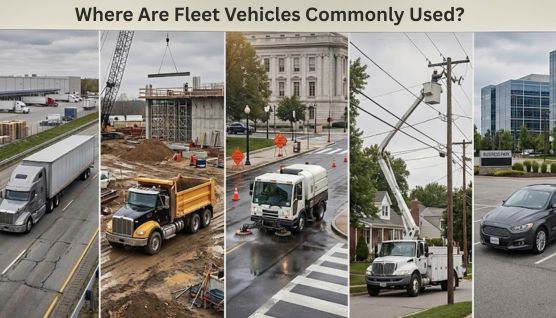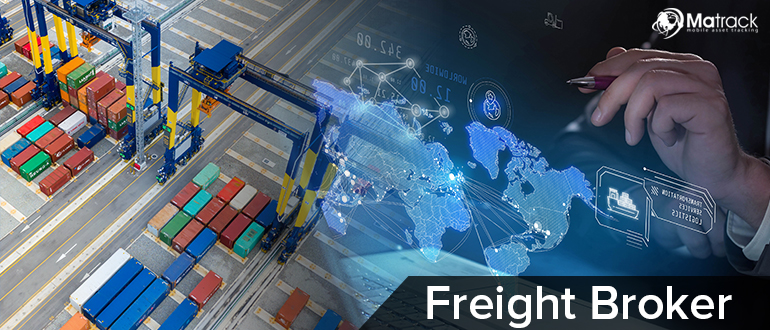A fleet vehicle is a car, truck, van, or specialized vehicle that a business or organization owns or leases for work-related activities. It supports daily operations such as deliveries, field services, employee transport, or moving equipment.
Unlike personal vehicles, fleet vehicles are managed as part of a coordinated system rather than individually. This means their usage, maintenance, and performance are tracked together to improve efficiency and reduce operating costs.
Because fleet vehicles directly impact productivity and expenses, businesses often manage them using tools like GPS tracking and scheduled maintenance plans. This structured approach helps organizations stay organized, compliant, and prepared as their transportation needs grow.
Where Are Fleet Vehicles Commonly Used?
Fleet vehicles are commonly used in industries where reliable transportation is essential for completing daily tasks, serving customers, and maintaining consistent operations.

Logistics
Delivery companies and distribution businesses depend on fleet vehicles to move goods efficiently between warehouses, stores, and customers. These vehicles help maintain delivery schedules while controlling fuel use and route efficiency.
Construction
Construction companies use fleet vehicles to transport workers, tools, and materials to job sites. Since vehicles are often used heavily, strength, load capacity, and reliability are especially important in this environment.
Government
Municipal and government agencies operate fleet vehicles for public services such as policing, road maintenance, and waste management. These fleets focus on safety, compliance, and long service life to support essential community operations.
Utilities
Utility providers use fleet vehicles to inspect, repair, and maintain infrastructure like power lines, pipelines, and communication networks. Having dedicated vehicles allows technicians to respond quickly to outages and service requests.
Corporate
Businesses use fleet vehicles to support sales teams, service staff, and internal transportation needs. In addition to improving mobility, these vehicles often help reinforce a company’s brand through consistent appearance and usage.
What Should You Consider Before Buying a Fleet Vehicle?
Before purchasing a fleet vehicle, businesses need to evaluate how well the vehicle will support daily operations, long-term costs, and future growth without creating unnecessary inefficiencies.
Usage Needs
Start by identifying exactly what the vehicle will do each day. The job it performs—like carrying tools, making deliveries, or transporting teams, directly affects the model and configuration you choose.
Driving Conditions
Think about the environment the vehicle will operate in most of the time. City fleets need smaller, fuel-efficient models while rural or uneven terrain may call for larger, more rugged builds.
Cost Breakdown
Look beyond the upfront price and calculate fuel, insurance, maintenance, and resale value. A low-cost vehicle that burns fuel quickly or breaks down often can cost more over time.
Fuel Type
Match the fuel system to how and where the vehicle will be used. Diesel works well for hauling and long routes, while electric suits short trips and low-maintenance cycles.
Maintenance Access
Make sure parts are available and service centers are nearby. Limited repair options increase downtime and reduce productivity across the fleet.
Safety Standards
Prioritize safety features like braking systems, driver alerts, and traction control. These reduce accident risks and help keep insurance costs manageable.
Built-in Tech
Look for vehicles with GPS, telematics, and remote monitoring. These tools help track performance, detect problems early, and improve driver accountability.
Resale Value
Some brands hold value longer and sell faster when replaced. High resale value reduces long-term costs and supports smoother upgrades.
Sustainability Plans
If your company is planning to go electric or reduce emissions, the vehicles you choose must support that shift. Electric and hybrid options can future-proof your fleet and lower fuel spending.
Is It Better to Buy or Lease Fleet Vehicles?
Buying gives full ownership and long-term value, making it better for high-mileage or heavy-use fleets. It allows customization and avoids penalties tied to wear or overuse.
Leasing lowers upfront costs and keeps payments predictable, which helps with budgeting and cash flow. It’s ideal for businesses that upgrade vehicles often or prioritize lower maintenance responsibility.
The right option depends on how long the vehicle will be used and how hard it will be driven. Comparing total cost of ownership and operational flexibility helps make the best decision.
Read More: Fleet Leasing vs. Buying
How Do Businesses Manage Fleet Vehicles?
Track Usage
Use GPS and telematics to keep an eye on vehicle movement, route history, and overall performance. This helps fleet managers understand how each vehicle is being used throughout the day.
Real-time tracking makes it easier to spot inefficiencies like detours, long idle times, or unauthorized stops. Over time, this data improves route planning and reduces unnecessary fuel cost.
Schedule Maintenance
Routine servicing prevents mechanical failures and keeps vehicles road-ready. Maintenance schedules should be based on mileage, engine hours, and manufacturer recommendations.
Using reminders and logs to track oil changes, brake checks, and inspections ensures nothing gets missed. Staying proactive reduces emergency repairs and keeps downtime to a minimum.
Monitor Drivers
Driver behavior has a direct impact on fuel efficiency, safety, and vehicle wear. Using telematics, managers can monitor habits like harsh braking, speeding, and extended idling.
Addressing risky driving through feedback or training lowers accident rates and extends vehicle life. It also improves overall fleet reliability and reputation.
Control Fuel Costs
Fuel is one of the highest recurring expenses in fleet operations. Using fuel cards linked to tracking systems helps monitor spending and prevents unauthorized purchases.
Route optimization software helps reduce distance traveled and time spent in traffic. These changes lower fuel usage and cut operational costs without reducing service quality.
Keep Records
Accurate logs for each vehicle help manage maintenance, repairs, fuel usage, and driver assignments. These records serve as proof during audits or warranty claims.
Digital records also provide insights into long-term performance trends. This allows better forecasting and planning for future fleet decisions.
Ensure Compliance
Fleet vehicles must meet state and federal regulations related to safety, emissions, and licensing. Failing to stay compliant can result in heavy penalties or service disruptions.
Setting up automated reminders for inspections, insurance renewals, and certifications keeps everything up to date. It also protects the organization from legal and financial risks.
Use Fleet Software
Fleet management software brings all key data, location, maintenance, fuel use, into one dashboard. This allows faster decisions and easier oversight across multiple vehicles.
Automation reduces manual work like logging service schedules or tracking mileage. A centralized platform improves accuracy and saves time for fleet managers.
Plan Replacements
Every vehicle has a usable life span based on mileage, condition, and purpose. Knowing when to replace a vehicle prevents unexpected failures in the field.
Setting replacement policies based on cost-per-mile and maintenance frequency keeps the fleet efficient. It also ensures employees always have access to safe and reliable vehicles.
Related: What is Vehicle Fleet Management?
What Are The Benefits And Challenges Of Fleet Vehicles?
| Benefits | Challenges |
| Centralized control over operations | High upfront purchase or lease cost |
| Lower cost-per-mile with optimized usage | Ongoing maintenance and repair responsibilities |
| Improved branding with vehicle customization | Complex regulatory and insurance requirements |
| Real-time tracking through telematics | Risk of driver-related incidents or misuse |
| Bulk pricing and tax incentives | Requires dedicated management and oversight |
| Predictable service with standardized assets | Vehicle downtime can impact daily operations |
What Tools Are Used for Fleet Vehicle Management?
Businesses rely on specialized tools to monitor fleet vehicles, reduce manual work, and keep operations efficient as fleets grow in size and complexity.
GPS Tracking
GPS tracking tools show real-time vehicle locations and movement history. This visibility helps improve routing, reduce unauthorized use, and respond quickly to delays.
Telematics Systems
Telematics platforms collect data on speed, braking, idling, and engine performance. This information supports safer driving, lower fuel usage, and early issue detection.
Maintenance Software
Maintenance tools track service schedules based on mileage or time. Automated reminders help prevent missed servicing and reduce unexpected breakdowns.
Fuel Management Tools
Fuel management systems monitor fuel purchases and consumption patterns. They help identify waste, prevent misuse, and control one of the largest fleet expenses.
Driver Monitoring Tools
Driver monitoring solutions focus on behavior behind the wheel. Alerts and reports highlight risky habits so managers can address issues through coaching or training.
Fleet Dashboards
Centralized dashboards bring vehicle data, maintenance records, and performance metrics into one view. This allows faster decisions and better control across the entire fleet.
How Does Fleet Management Software Improve Fleet Operations?
Fleet management software brings vehicles, drivers, and operational data into one system, making it easier for businesses to control costs, improve visibility, and scale efficiently.
Centralization
Fleet management software centralizes vehicle data, maintenance records, and driver activity in one platform. This eliminates scattered spreadsheets and manual tracking.
Real-Time Visibility
Live tracking allows managers to see where vehicles are at any moment. This improves dispatch decisions and helps respond quickly to delays or issues.
Maintenance Control
Automated maintenance scheduling ensures vehicles are serviced on time. This reduces breakdowns and extends vehicle lifespan.
Driver Accountability
Driver behavior data highlights speeding, harsh braking, and idling. These insights support coaching and safer driving habits.
Cost Optimization
Fuel usage, routes, and idle time are analyzed to reduce waste. Over time, these efficiencies significantly lower operating expenses.
Scalable Management
As fleets grow, software allows operations to scale without added administrative burden. Managers can oversee more vehicles without losing control.
Which Is The Best Fleet Vehicle Management Solution?
Matrack stands out as the best fleet management solution because it’s simple to use and packed with essential tools. It gives you real-time GPS fleet tracking, driver behavior alerts, and maintenance reminders all in one place.
What makes Matrack even better is how accessible it is for any business size. There are no long-term contracts, and the monthly plans are affordable without cutting back on key features.
If you want something that’s reliable, scalable, and easy to manage, Matrack is the top choice. It’s consistently rated high by users for performance, support, and overall value.



